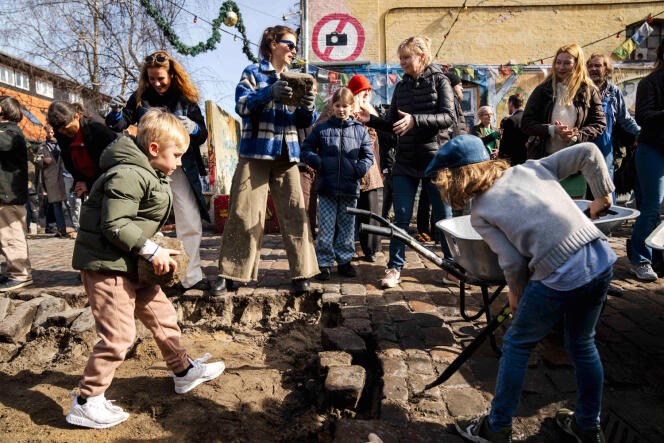


"Pusher Street" is no more. On April 6, in a festive atmosphere and glorious sunshine, residents of Copenhagen's self-governed Christiania neighborhood dug up the cobblestones of one of Denmark's most famous streets. After a new wave of violence, which has claimed three lives in less than three years, the "Christianites" decided to destroy the hundred-meter-long alley once and for all, and to expel the "pushers" – or "dealers" in English – by removing their stalls, made from sheet metal and wooden pallets, which had made the area a tourist attraction.
Nearly 770 adults and 220 children live in the enclave. They came to the event, described as "historic," as families, bustling about to the sound of Another Brick in the Wall (Pink Floyd) over the loudspeakers. They passed the cobblestones from one hand to another and piled them up in a courtyard. Some kept one as a souvenir. Others filmed the scene on their phones, defying for the first time the signs painted on the walls by the drug dealers, who ban pictures in Pusher Street.
Wearing a fluorescent orange Lycra T-shirt and black jogging pants, Klaus Danzer fought back tears. Originally from Germany, the 59-year-old carpenter has lived in the neighborhood for about 30 years. Two years ago, he became the face of the Nok er Nok – "enough is enough" – movement. It was created after a 22-year-old Christianite was killed on Pusher Street on July 3, 2021, "probably by mistake," according to Danzer, who had known the victim since she was a child.
In October 2022, a 23-year-old man was shot twice in the head not far from the alley. Then, on August 26, 2023, a shootout broke out. It was around 7:30 pm, and the neighborhood was packed. A man with gang connections was killed. Four bystanders were wounded, including two foreign tourists. The next day, residents gathered at Den Grå Hal, a concert hall where Bob Dylan, Patti Smith, and Metallica have all performed. They decided to close Pusher Street.
It isn't the first time locals have tried to get rid of drug dealers. "This time it's different because the decision didn't come from the top, and we have the support of the state and the city," said architect Mette Prag, one of the neighborhood's spokeswomen. Copenhagen Mayor Sophie Hæstorp Andersen and Justice Minister Peter Hummelgaard Thomsen came to have breakfast with the residents on April 6, before each leaving with a cobblestone.
The government has promised to invest 14.3 million kroner (almost €2 million) in renovating the district and building 15,000 square meters of low-cost housing. It marks a small revolution for Christiania, whose residents have always opposed state intervention, seen as an attempt at normalization.
You have 46.46% of this article left to read. The rest is for subscribers only.
